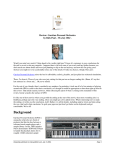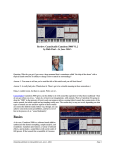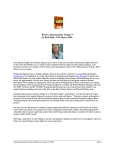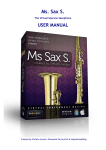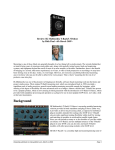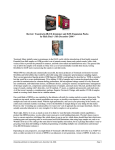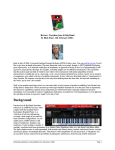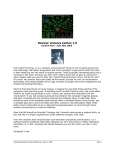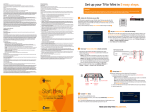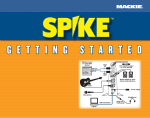Download Review: Garritan Stradivari Solo Violin Created by
Transcript
Review: Garritan Stradivari Solo Violin Created by Giorgio Tommasini, Stefano Lucato & Gary Garritan by Rick Paul - 13th March 2006 - I have a confession to make. When I heard, well over a year ago now, that Garritan Orchestral Libraries had announced a future product called Garritan Stradivari Solo Violin (GSSV), the product's name left me less than excited, and I really didn't pay much attention to the details of the announcement. Don't get me wrong, the idea of the value of a Stradivari violin is by no means lost on me. No, it was simply that I'd become a fairly recent user of Garritan Personal Orchestra (GPO) at that point, and it already included multiple sampled instruments, including solo violins, and one of those was also a Stradivarius. Moreover, I was already pretty pleased with the solo violins in GPO, which I considered to be a big step up, in terms of playability and sound, from solo violin sounds I'd been using prior to that point. To be honest, it was simply hard for me to conceive that a sampled instrument could up the ante very much, in terms of achieving performance capabilities and realism significantly more like a real violin. There would still be the limiting factor of a player's using a MIDI keyboard, and some associated continuous controllers, to play the instrument. I mean we are talking here about trying to emulate an acoustic instrument that has all kinds of expressive capabilities that keyboards just don't provide. There are just too many combinations of things a real violin player can do. How could you possibly provide the ability to cover enough combinations, especially in the context of the player's ability to change things in real time performance, where you can't predict at the start of a note what that player may do over the course of the note? There was another consideration, as well, though. As good as the GPO solo violins were in a classical violin context, what I needed far more often were violins that worked in a country fiddle context. Somehow I don't think of the name "Stradivari" and "country fiddle" going together. I mean how many country fiddlers can afford a 300 year old, million plus dollar instrument? Somehow the product name just didn't suggest it was aimed at any of my pressing needs, so I more or less just let it pass by without taking notice. Cut to late last year when Garritan announced the imminent shipment of GSSV, and I decided it was time to look a little more closely at the product details, to see if I should care. I'm certainly glad I did, and the answer is a resounding, "yes!" The first thing I noticed was that one of the MP3 demos on the Garritan site was of a classic country fiddle song called "The Orange Blossom Special". Needless to say, that was the first one I played, and it did sound like a fiddle, not a classical violin sample trying to play a fiddle part. The other MP3 demos, which covered a variety of styles, also sounded quite impressive, but it was a video demo of the product that really caught my attention. That demo showed how a keyboard(!) player would cover playing various violin techniques, and made it fairly evident that GSSV was not just your typical sampled violin, but likely a new state-of-the-art, not only in modeling the violin, but very possibly in the general quest to model acoustic instruments in a way that both is extremely realistic and provides the potential for highly satisfactory real-time performance. Originally published on CakewalkNet.com, March 13, 2006. Page 1 If you haven't yet checked out the GSSV video, you can find it here. (The technique videos are down near the bottom of the page. There are multiple videos, but the main one I'm talking about is the "Real Time Articulations Video".) We can wait... If watching that video instantly caused you to add a couple hundred dollars to your credit card balance, please convey my apologies to your significant other. In the meantime, let's look at GSSV in more detail. Background The development efforts that resulted in Garritan Stradivari Solo Violin began back in 2001 as a collaboration between an Italian team and Gary Garritan, who supplied the Stradivari samples. Besides Garritan, the founders of the team included Giorgio Tommasini, who developed the patent-pending phase alignment and other techniques underlying GSSV, and Stefano Lucato, a professional musician and sound engineer. Unlike, Garritan's most recent product offerings, Garritan Personal Orchestra and Garritan Jazz & Big Band Ensemble, both of which came bundled with the KONTAKT Player needed for playing the sampled instruments in those libraries, GSSV provides a KONTAKT 2-based sample library only. If you don't already have KONTAKT 2, you will need to acquire it separately to play GSSV. Besides KONTAKT 2, which runs on PCs with Windows XP and Macs, and provides a standalone player as well as various plug-in formats (DXi, VST, and RTAS on Windows; Audio Units, VST, and RTAS on Mac), Garritan lists the following requirements for GSSV: • • • • • • DVD drive 500 MB of available disk space 1GB or more of RAM Pentium 4/Athlon 2.6+ GHz (or comparable Mac) for optimal real-time performance A low latency sound card -- either ASIO for use with KONTAKT 2's standalone interface, or ASIO or WDM kernel streaming for use inside SONAR MIDI keyboard with six or more octaves, and the following controllers: o Pitch Wheel o Mod Wheel o Sustain Pedal o Channel Aftertouch o Expression Pedal The product package includes a DVD with a single KONTAKT 2 format instrument, as well as a very thorough 44-page manual. That's right, I said 44 pages -- all for a single sampled instrument! The information in the manual of course includes the technical information you'll need to play the instrument, such as controller uses. It also includes a wealth of information on violin playing terms and techniques, including how to play them with GSSV. Beyond that, though, there are also history lessons on Antonio Stradivari and his violins, information on the philosophy behind, GSSV, brief biographies on the key developers of the product, and even a foreword by music technology writer Craig Anderton. Not literally included in the product package, but a big part of the overall value of GSSV is Garritan's excellent support, including forums which provide high quality support (Giorgio Tommasini is among the regular contributors to the forum), tutorials, and more. Garritan has a track record of updating products long after their initial release, and GSSV already had an update available for free download by the time I received the product. I had a minor problem loading the GSSV instrument sample in KONTAKT 2 initially, due to some differences in sample directory paths on my system versus the one on which GSSV was created. A quick look through the support forums turned up a Originally published on CakewalkNet.com, March 13, 2006. Page 2 solution, which was to manually point KONTAKT 2 to the correct directories, then resave the instrument under a new name, loading the revised instrument from that point forward. GSSV lists for $199, and street prices seem to be identical. If you don't already having KONTAKT 2, you'll need to add that to the price tag for GSSV. The list price for KONTAKT 2 is $449, with the best street price I found as of this writing around $375. If you have KONTAKT 1.x, however, the upgrade to KONTAKT 2 lists at $139, with the best street price right around $100. If you don't have KONTAKT 1.x, but do have NI's KONTAKT or INTAKT, or third party sample libraries that provide a KONTAKT, INTAKT, or KOMPAKT player -- e.g. Garritan's GPO and JABB would qualify here -- the crossgrade to KONTAKT 2 lists at $269, with the best street price I found at $249. All testing for this review was carried out in KONTAKT 2.0.2.007 under SONAR 5.0.1 Producer Edition. The VST instrument of KONTAKT 2 was used. A Violin is a Violin is a ... NOT!!! It probably wouldn't surprise you if I said that all sampled violins are not created equal. The idea of sampling is to use a recording of the actual instrument being modeled to try and achieve a high level of realism. In practice, though, violin samples have ranged from downright laughable -- along the lines of what you might expect from one of those cheap auto-accompaniment keyboards your local electronics superstore -- to "reasonably convincing in certain contexts." However, those "certain contexts" would generally not include any amount of exposed playing. Or, if they did include some exposed playing, the type of exposed playing would have to be highly limited. For example, fast runs might be able to slip by, but slow, expressive playing wouldn't even fool a casual listener. One of the biggest issues in this area was that most sampled instruments use pure sample switching, or possibly sample crossfading. That is, when you hit a note at a particular velocity, the sample used is chosen based on that velocity, and that sample is used through the duration of the note. There might be some samples available with swells, fades, and other volume-oriented characteristics, but those would be in the samples themselves, not something you could control in real time. You might be able to use a volume control to play around with the volume in real time, but that wouldn't be the same as what happened on a real instrument where timbre also changed with changes in volume. Garritan Personal Orchestra tackled this problem through clever programming to adjust both volume and timbre in response to movements of the MIDI controller's mod wheel (MIDI CC#1). For example, the graphic at the right of this paragraph shows an annotated single note MIDI clip from SONAR 5's Track View. Overlaid on the note is a track envelope to set mod wheel values. The curve shown makes the note start out at a medium volume, back off significantly, and then rise to a very loud volume before fading out completely toward the end of the note. Let's have a listen to this MIDI clip being played back by GPO's Violin 2 Strad KS Solo: GPO solo violin sfz then swell We get dynamic and timbral movement over the course of the note, but, if you listened closely, you most likely heard a bit of a bump right around the middle of the held note. This represents the point where GPO's programming switches between softer samples and louder samples. If you listened even more closely, my may have also noticed that the vibrato in the sample didn't feel terribly natural. Originally published on CakewalkNet.com, March 13, 2006. Page 3 Aside from having some hesitation around the same place as the lump in the samples, the rate was fairly constant throughout, whereas a real player would vary the rate over time, likely speeding the vibrato up somewhat as the note progressed. Vibrato depth might also have varied over the course of a real player's note, while the vibrato depth was relatively constant in our sample once the vibrato ramped up after the start of the note. Are we being picky? You bet. We are taking what might well be a worst case -- holding a single note out for two measures (at 100 BPM) -- and wanting to hear movement of different types in different dimensions, including changes in dynamics, timbre, vibrato rate, and vibrato depth. While GPO's Stradivari violin delivers changes in dynamics and timbre, the technology available at the time placed limitations on how smoothly it could deliver those changes, and our desires in the area of vibrato changes were simply wishful thinking. What GPO does deliver here might sound just fine in an ensemble context. However, in this highly exposed setting, we're not even close to being fooled that we're listening to a real player playing the instrument. GSSV improves things significantly. Instead of using mod wheel for volume and related timbral shifts, GSSV uses an expression pedal (MIDI CC#11). GSSV also provides real-time control over vibrato speed (aftertouch) and vibrato depth (mod wheel/MIDI CC#1). The screen clip at left shows the same note as above, substituting the Expression pedal for the mod wheel, then adding aftertouch to increase the rate of vibrato as the note is held and mod wheel to increase, then decrease the depth of the vibrato. GSSV also employs some significant new technology, which we'll discuss more below, to smooth out what actually happens in response to these controls. Let's have a listen: GSSV sfz then swell with vibrato changes Ignoring for the moment how realistic, or not, my programming may have been in terms of emulating what a real violinist might do, comparing this sample to the previous one makes one thing immediately clear: There are no lumps! Not only do we not hear sample switching to deal with timbral and dynamic shifts, but we also get continuously changing vibrato rates and depth at the same time! Listening to this highly exposed note in all its nakedness, there really aren't any telltale artifacts to let us know this is a sampled violin. In fact, about the only thing that might give it away is that the pitch is too perfect. However, we could add a bit of pitch bend to remedy that. Before we talk about the technology behind GSSV, let's take a graphic look at the waveforms we just heard. The screen clip at right shows two examples from SONAR 5's Track View after bouncing the two measures in question to audio tracks. The top track is the wave rendered with GPO, and the bottom is from GSSV. Slight differences in volume response aside, note how smooth the GSSV audio's waves are compared to those from GPO. The lump Originally published on CakewalkNet.com, March 13, 2006. Page 4 we heard around the middle of the note in GPO is clearly visible, and it is easy to notice a significantly different shape in the front and back halves of the note. Note also the differences in vibrato patterns. With GPO, there is a constant vibrato at the start of the note, an aberration near the middle of the note, then the vibrato almost gets obscured by the louder sample itself on the tail end of the note. With GSSV, though, the only changes in vibrato are the ones we purposely put there, and they enter and progress smoothly. Building a Better Sampled Violin The GSSV documentation lists eight goals of the development team's nearly five-year effort to design and build a significantly better sampled violin: 1. 2. 3. 4. 5. 6. 7. 8. Implementation on a conventional sampler Real time playability Real time, continuous transition (morphing) across several dynamics of the same note Real time, continuous transition between vibrato levels Real time control of the vibrato intensity & rate Real time portamento & legato Real time shaping of most articulations Timbral characteristics indistinguishable from the original samples The first goal simply avoids reinventing the wheel, allowing the development team to focus on designing the sampled instrument, rather than sampling engine. It also recognizes the value of starting with recordings of an actual instrument, rather than physically modeling an instrument. We'll take a look at the real time playability of the instrument in the next section of this review. One could say that goals number 2 and 8, which combine together to target an instrument that sounds extremely authentic while being playable in real time, are the overarching goals of the project. The rest of the goals, which we will be discussing imminently, are details that factor into supporting these two high-level goals. The third goal, being able to smoothly morph between different dynamics of the same note, while keeping in mind the goal of achieving timbral characteristics indistinguishable from a real violin doing the same thing, was one of the key challenges faced by the development team. Conventional samplers either switch or crossfade between samples. When switching between samples, there would be a decided non-continuity, and a smooth transition between dynamic levels would not occur. Crossfading could work for doing this with ensembles, with many instruments playing together, but this would result in noticeable phasing issues between two samples of the same instrument. Let's take a look at the nature of this problem. The diagram below shows zoomed in samples of a violin playing the same note at two different dynamic levels, both without vibrato: The top sample is played mezzo forte and the bottom sample is played mezzo piano. Were we to crossfade between these two samples, you would hear artifacts where the two samples were playing together. The reason is that there is no phase alignment, or even obvious potential for phase alignment, between the two samples. This problem was solved using a patent-pending technique invented by Giorgio Tommasini. That technique is referred to as Harmonic Alignment. The idea is to match up the phase of all corresponding harmonics of the same Originally published on CakewalkNet.com, March 13, 2006. Page 5 note at each dynamic level, which then allows crossfading between levels without the otherwise inherent phasing issues. The diagram below shows the same sounds above after being processed to phase align their harmonics: In this revised view, phase alignment of the samples is clear, and the two sounds can be blended seamlessly. It is also important to note that this process of matching the phase of the corresponding harmonics does not alter the timbre of the sounds. Thus, the result provides both the seamless transition between dynamic levels and timbre that is indistinguishable from the original samples. Note that the processing is Harmonic Alignment processing is done as part of the process of developing the sample library. Thus, it is not placing extra processing demands on your CPU during playback, nor requiring specialized processing techniques to be implemented by the sampler. The fourth and fifth goals of the GSSV project, namely providing seamless transitions of vibrato levels while allowing the player real time control over vibrato rate and intensity, were another major challenge facing the development team. Conventional samplers allow switching between samples with no vibrato and samples with vibrato, but they do not provide the ability to modify the vibrato intensity and rate under the user's control. When this type of control is needed, LFOs (low frequency oscillators) are typically used to modulate the amplitude (i.e. loudness/softness) and frequency (i.e. pitch) of the overall sample. While this does provide real time control, the processing is applied equally to each harmonic of the sound, whereas realistic vibrato results in amplitude modulations that are out of phase with each other. The reason for this is that the sound of the vibrating string is not the only thing that affects the resulting sound -- the sound is also affected by being bounced around the body of the instrument. This problem was solved by another patent-pending technique, developed by Giorgio Tommasini and Stefan Lucato. The technique starts out similarly to conventional LFO-based techniques, using LFOs to generate the frequency modulations, and providing LFO controls for intensity and rate. However, it then uses a specially devised impulse response based on the analysis of the sounds produced by the real instrument, as opposed to simply based on the body of the instrument, in conjunction with the convolution processor included in KONTAKT 2's slate of insert effects, to process the output. It is this calculated impulse that keeps the actual results of the overall processing consistent with the sound of the real instrument, while still allowing for real time user control. The sixth goal, which is basically dealing with portamento and legato in real time, was accomplished by using KONTAKT 2's script processor. The script processor is used to implement algorithms which track what the user does in areas such as overlapping notes, timing, and the flow of note velocities, then translate those to portamento and legato decisions. In a sense, the GSSV programming is using artificial intelligence to determine the user's intentions, then translating that to violin playing techniques. The seventh goal, real time shaping of articulations takes advantage of a modular sample structure, which divides the sample components into attacks (i.e. articulations), sustains, and release triggered notes (e.g. the bow bouncing off the strings). A traditional sample library might require separate samples for different dynamic level combinations with different bowing attacks. However, GSSV blends the proper bow attack with any dynamic levels, to smoothly create any combinations needed as indicated by the combination of note on velocity (for strength of the attack), expression pedal (to govern the dynamics of volume and timbre), keyswitching (to call up special articulations), sustain pedal (to trigger bowing direction changes), and script-based analysis of the user's playing (to determine when to use legato, portamento, and various other playing techniques). Originally published on CakewalkNet.com, March 13, 2006. Page 6 At the architectural level, GSSV builds upon the powerful KONTAKT 2 sampling engine, script processor, and convolution effect as follows: • • • Pre-processed samples, which are phase aligned for each harmonic, are used to allow crossfading without artifacts. A specially constructed impulse response, derived from in-depth analysis of the sounds produced by the instrument, is used to recreate realistic vibrato and portamento from non-vibrato sounds. A MIDI processing script analyzes what the player is doing (e.g. with respect to note overlap, timing, etc.), and translates this into a sophisticated series of commands to the sampler to emulate violin techniques. Enough talk about technology and sampled instrument development techniques! Let's see how GSSV plays! Fiddling Around Pretty much as soon as I had GSSV installed properly, and took a quick look at the manual to check on which controllers did what, I was up and playing. Within about an hour after that I made two quick attempts at doing fiddle parts. That was enough to satisfy myself that what I could achieve out of the shoot with GSSV was at least an order of magnitude more realistic than the results of any of my previous attempts at fiddle emulation. I also learned that it might take me some time to practice with GSSV, to build up my technique with the instrument. Taking a step back for a moment, there are two key complications in my setup that work against my potential for playing GSSV in real time: One is that I don't have an expression pedal (yet -- GSSV has definitely put this on my list of priorities for future purchases). While I programmed a slider on one of my keyboards to send CC#11, I'm not coordinated enough to use multiple fingers for independently controlling multiple sliders at once with my left hand while playing emotionally with my right hand. Having played organ enough in the past, I'm confident that adding an expression pedal will be comfortable for this purpose, but I did not get the chance to try one for this review. I addressed this limitation by overdubbing some controllers after the initial part was recorded. Which controller(s) got overdubbed depended on my mood of the day, and it wasn't quite as musical as playing everything in real time. Nevertheless, it worked just fine, and, in fact, in some circumstances I preferred the level of fine control doing that gave me, and even overdubbed more controllers than I actually needed to do. The second is that my computer, which is based on the Athlon XP 1600+ with 1 GB of RAM, is decidedly not state of the art. In fact, is significantly less powerful than the 2.4 GHz or better system Garritan recommends. (While KONTAKT 2 calls for a minimum of a 1 GHz system, and my system does meet that spec, the recommendation is for a 3 GHz system.) While I could easily play GSSV in the standalone mode of KONTAKT with no artifacts at a latency of 5 ms, I had mixed results when using GSSV in SONAR. Whether I could successfully record it without hearing artifacts, even at higher latencies, depended strongly on what else was going on in the project. The types of artifacts I would get ranged from crackles to notes' cutting out temporarily. Those artifacts would only be heard when monitoring GSSV during recording, and would not be present in a bounce, or even later playback of the recording at the same latency in many cases. Still, they could be distracting when recording. I should note that I have seen a similar problem with a number of other softsynths in SONAR 5.0.1 on my system, so I do not consider this to be a GSSV, or even KONTAKT 2, problem. It is simply a fact of life with any heavy duty softsynths, especially when recording multiple continuous controllers in parallel, under the SONAR 5.0.1 (and probably SONAR 4.0.3 and later) thread prioritization scheme, on my aging system. So, if anyone has a 3 GHz system they're not using... My system's shortcomings aside, GSSV really is a pleasure to play, and is perhaps the most expressive sampled instrument going at this point in time. Here is a quickly recorded and mixed rendition of the classic folk song "Red River Valley": GSSV plays "Red River Valley" Originally published on CakewalkNet.com, March 13, 2006. Page 7 There are a few things worth mentioning about this example: First, I am using none of the special articulations available through keyswitching. This example was simply created by playing the part, and overdubbing some of the controllers afterward. (I initially played notes, sustain pedal, and aftertouch live, then overdubbed expression, pitch wheel, and mod wheel in separate passes.) When I played this, I had not yet come to grips with controlling the rate of portamento through playing technique. In fact, I hadn't even read that part of the user manual. Even so, what GSSV does with natural keyboard playing techniques is quite passable. Probably the most "offensive", if you will, part of this performance is my somewhat overbearing, and inconsistent, use of vibrato. My point in leaving it in, rather than holding out for a better performance, is to demonstrate that, like any musical instrument GSSV requires practice for best results. There are two parts to this practice. One is developing the necessary coordination to do multiple things in parallel to get the result you desire. The other is developing your ears to the point that the results you desire are tasteful and natural for the instrument (i.e. assuming your ultimate goal is emulation of a skilled violin player playing a high quality instrument). Finally, all caveats aside, I hope this example will demonstrate the expressive potential of GSSV, even in the hands of a relative novice at playing it. GSSV goes far beyond the level of the above example, however. Once you bring keyswitching to the table, a range of specialized techniques becomes available with relative ease. For example, if you want a trill, with many sampled instruments you would need to rapidly alternate between both notes in the trill, or possibly play a canned trill sample that limits your flexibility. With GSSV, simply invoke the keyswitch for trills, then hold the first note of the trill down while playing the other note as rapidly as you want it to occur. The intelligence within GSSV's KONTAKT 2 script alternates between the two notes for you, and you only have to play half as rapidly as you want the trilling notes to alternate. When you're not trilling, leaving the trill keyswitch on largely behaves similarly to GSSV's main mode of operation. If you want to play con sordino (i.e. with mute), another key switch provides that effect. The playing technique is the same as the normal mode, but the main difference noted is the muted sound when sustaining notes. Pizzicato (i.e. plucking the strings, rather than bowing) is another keyswitch. Spiccato attacks (i.e. attacks played with the point of the bow) are another keyswitch. Etc. Most playing techniques cross over the different keyswitched modes, with the exception of when you are playing the particular technique in question. This essentially makes GSSV like learning one basic instrument, along with a variety of advanced techniques. For the most part, those advanced techniques are fairly easy to master, too. After playing with GSSV for what would probably total a full day, albeit elapsed over a few sessions spread a few weeks apart, I by no means feel like an expert at playing it. Nevertheless, I've started to feel comfortable with many of the techniques. I am also getting much smoother in terms of controlling my attacks, use of portamento, use of vibrato, switching between single and double stops, and even performing my most common keyswitching moves in real time (and without having to refer back to the user manual). While I've still got a long ways to go to master the instrument, I'm am amazed at the range of expression I've been able to achieve thus far, and the expressiveness of the instrument has gotten me thinking about how I can use it in new contexts. Heck, I've even found myself doodling in a classical style! Closing Notes I have now become a big fan of GSSV. It is a pleasure to play, and the expressive capabilities, as well as the potential for realism in emulating a real violinist playing a real violin, go significantly beyond the previous state of the art. Anyone who regularly needs to emulate violin or fiddle playing in their work, especially in an exposed context, and where simply hiring a talented violinist is not an option, now has a strong option where one did not previously exist. At the same time, GSSV's price point, especially for users who do not already have KONTAKT 2, is likely to limit its popularity somewhat compared to GPO and JABB. Essentially, it can be a pretty steep price tag for a single Originally published on CakewalkNet.com, March 13, 2006. Page 8 instrument. Of course, it is way less than even a high quality student model fiddle, and that is to say nothing of the years of practice to build up to having a tone of the caliber GSSV gives you instantly. Thus, GSV is an excellent value, even if not everyone will need it enough to warrant its price tag. The bottom line is that this is truly a breakthrough instrument. In fact, one might go so far as to say it is the Stradivari of software instruments. Special thanks to Giorgio Tommasini for providing additional documentation and insight into the inner workings of GSSV. Late Breaking News As this review was going to press -- er, the web -- Gary Garritan indicated that a KONTAKT 2 Player-based version of GSSV will be released in April 2006. It is expected to be the first sample library released with the KONTAKT 2 Player. This version will support VST, DXi, AudioUnits, and RTAS plug-in formats (in the same platform configurations as KONTAKT 2). Preliminary pricing for the version of GSSV including the player has been estimated as $249, with an upgrade from the current library-only version available for $49. This new development could be welcome for prospective GSSV users who don't need KONTAKT 2 other than for GSSV, as it provides a potentially significant price break. The notion of there being an upgrade price from the current library-only version of GSSV initially struck me as curious. Why should users who already have KONTAKT 2 want to add the KONTAKT Player? However, looking at the preliminary screen shot provided by Garritan (see above), suggested some potential benefits in having a much more streamlined version, possibly with some meaningful controls directly in the plug-in interface. I also have to admit that I have always used the Garritan KONTAKT Players with GPO and JABB in the past, in large part because they are streamlined for the function at hand. Garritan also indicated plans to release additional stringed instruments based on the same technology as used in GSSV. Next up will be a cello, which should be available in a month or two. A viola and a double bass will follow, as well as a Guarneri del Jesu violin. *Rick Paul is a songwriter living in Southern California. You can contact him at http://www.RickPaul.info. Originally published on CakewalkNet.com, March 13, 2006. Page 9









